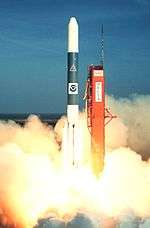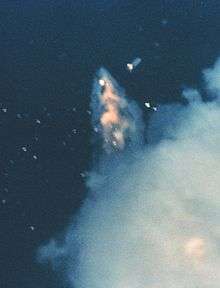GOES-G
 Artist's impression of an HS-371-derived GOES satellite | |
| Mission type | Weather satellite |
|---|---|
| Operator | NOAA / NASA |
| Mission duration |
Failed to orbit 7 years (planned) |
| Spacecraft properties | |
| Bus | HS-371 |
| Manufacturer | Hughes |
| Launch mass | 660 kilograms (1,460 lb) |
| Start of mission | |
| Launch date | 3 May 1986, 22:18 UTC[1] |
| Rocket | Delta 3914 D178 |
| Launch site | Cape Canaveral LC-17A |
| Contractor | McDonnell Douglas |
| Orbital parameters | |
| Reference system | Geocentric |
| Regime | Geostationary |
| Epoch | Planned |
GOES-G was a weather satellite to be operated by the National Oceanic and Atmospheric Administration. The satellite was designed to sense and monitor meteorological conditions from a geostationary orbit, intended to replace GOES-5 and provide continuous vertical profiles of atmospheric temperature and moisture. It was lost due to the launch failure of a Delta 3914 rocket on 3 May 1986.
Launch


Launch occurred on May 3, 1986 at 22:18 GMT.,,[2] aboard Delta 178, the first NASA launch following the Challenger disaster. 71 seconds into the flight, the first stage main engine shut down prematurely due to an electrical fault, and the rocket was destroyed by range safety.
Legacy
In 2015, director Ridley Scott used the explosion to depict the launch failure of the IRIS craft, in "The Martian".
References
- ↑ McDowell, Jonathan. "Launch Log". Jonathan's Space Page. Retrieved 2009-12-23.
- ↑ Encyclopedia Astronautica - Delta
